ENALENI ALCHEMY
Richard Haigh’s connections with soil, animal and life
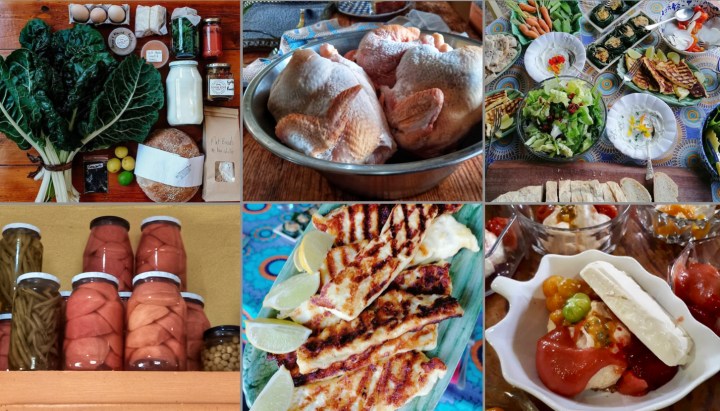
Richard Haigh delights in growing things: a fantastical medley of veg, a noisy menagerie of heritage-breed farm animals, his soil. He shares the bounty at monthly Enaleni Farm pop-ups. You like that succulent slice of pork? Come outside and meet its family.
The messages say, yes sure, I am welcome to come and experience “this type of madness”. That “we start milking at 7 o’clock; two goats and two cows. We stop for breakfast 9am to 9.30.” That he has arranged for a friend to come help with “the donkeys”. Around lunchtime he’ll do a bit of cooking prep. “I have an open day that’s fully booked and then an AGM I’m catering for.”
To get there, I should take the Richmond road off the N3 from Durban and “just after the chicken prison” (battery chickens) turn right. Up the hill. Right again. Then I’ll see the sign: Enaleni Farm.
A place this writer has wanted to visit for, goodness, 10 years. I see this from the August 2012 date on an email that pops up, having somehow archived itself through a couple of laptops. Curious and keen since then to hang out with Richard Haigh. Farmer, soil-nurturer, garden alchemist, solicitous “dad” to heritage chickens, pigs and Zulu sheep. “Midwife”, as needed, to happy cows and other expectant moms. Saver and rehabber of poached and abused donkeys.
Caring overseer in the relocation of Trouble (see Trouble and listen to the story here), a large spotted genet that stole and gobbled the head of one of Haigh’s prize show turkeys, taken by surprise while sitting on her eggs in a veggie patch two days after I was there.
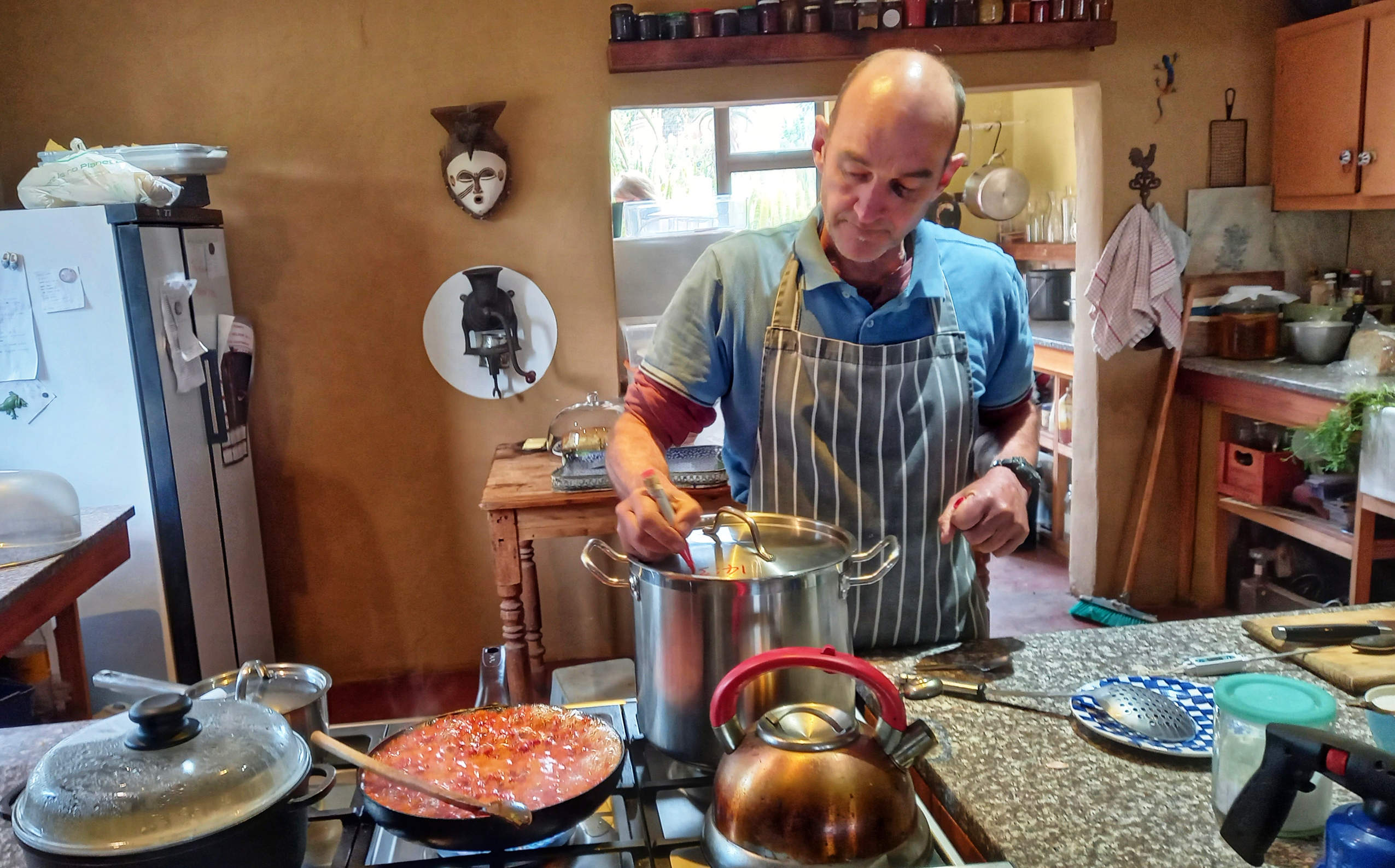
Richard Haigh in the kitchen at Enaleni Farm where he preps for the monthly ‘Eataleni’ lunches. (Photo: Wanda Hennig)
Also cheesemaker. And cheese-making skill-sharer, via monthly classes, of feta, halloumi, ricotta, hard cheese, brie, sometimes labneh (a strained yoghurt cheese) and angazi (which, smile, translates from isiZulu as “I don’t know” and gives a glimpse of Haigh’s playful sense of humour). All these made with what he calls “the miracle of milk, which is so versatile” from Enaleni’s hand-milked cows and goats.
“There is something very special when you make your own cheese that comes from your cow that you’ve raised and you’ve milked by hand. There’s a very special connection. There is something I think very energetically deep in that.”
Many other things he is, too, the most relevant, here and now, being founder-farmer-chef-creator of Enaleni’s monthly “Eataleni” pop-up eating experiences. “Alternative”, he calls them and indeed they are.
At least 85% of what you’re served is grown or raised within 150m of your plate. There is often mention of “breathing” items: unexpected surprise ingredients that might suddenly reveal themselves. And while there are many chefs who forage, he actually grows, produces, the whole bang shoot.
He had this vision when he moved here 15 years ago to have “this small working productive farm with animals that showcase heritage breeds farmed in a compassionate way. I do eat meat since I have lived here,” he says, “because I know how my animals eat and I am happy to slaughter what I eat. Generally, there is more of a movement now, people are searching for a connection with the soil and animals and production and health.”
Was it my imagination? Didn’t seem so. This strange sensation I experienced where the world shifted when I drove off the dirt side road through this small agroecological farm’s gate, got out of my car and locked eyeballs with one of several Izimvu — indigenous Zulu sheep. They appeared to be viewing me with as much curiosity as I was them. Not just this, but the whole time I was at Enaleni, I kept registering this sense of being hyper-alive and super-alert. At the same time, edgy-mellow, which sounds like a contradiction but didn’t feel like one. This to the constant soundtrack of broody chicken clucks, calls and cockadoodles, snorting pig noises, goat meeh-meehs and naa-naas, happy dog waggings, nuzzling donkeys giving subdued hee-haws. Seriously.
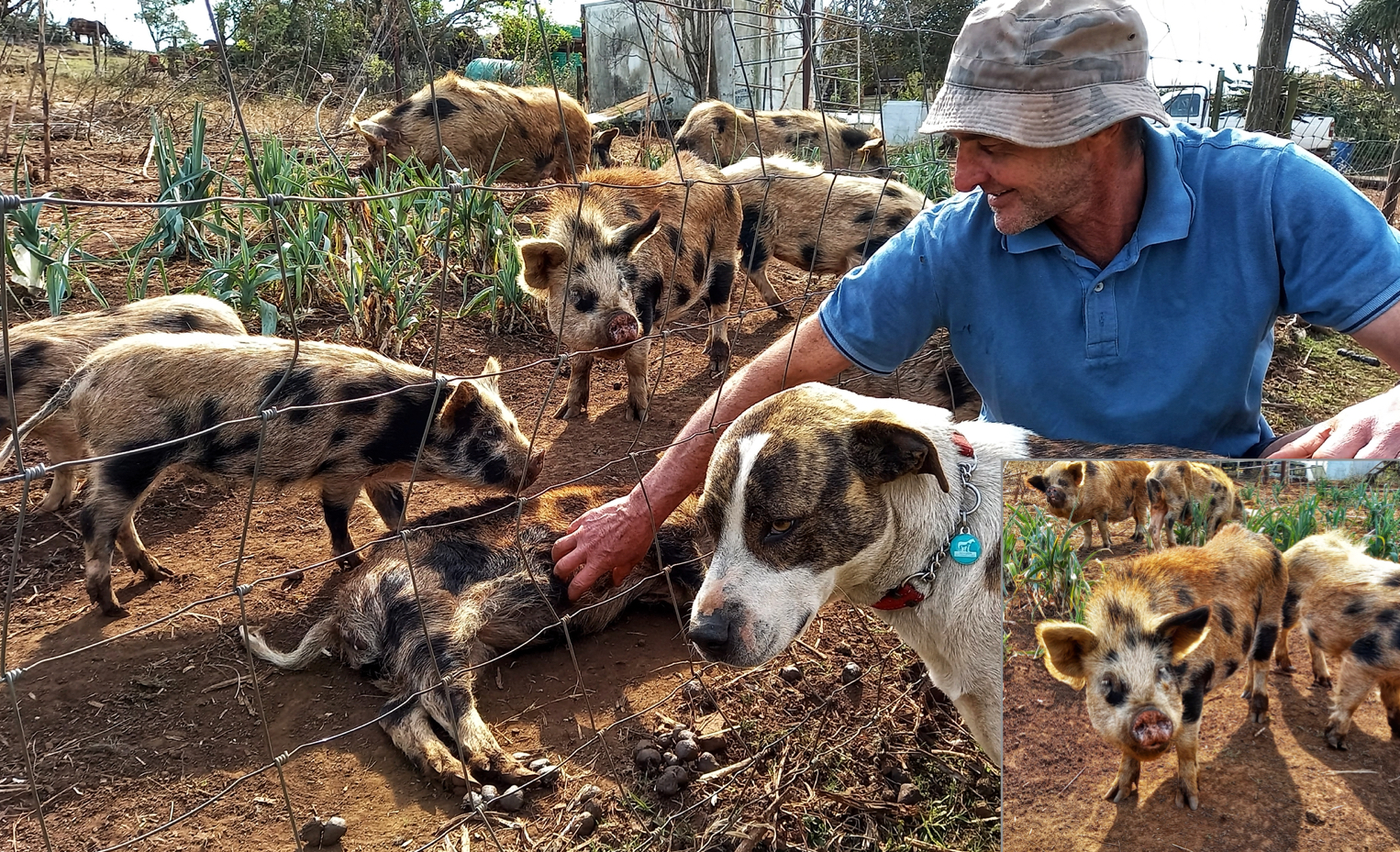
Richard Haigh gives one of his drift of flavourful heritage Kolbroek pigs a tummy rub. (Photo: Wanda Hennig)
At a multiple-course lunch, you might be served (indigenous South African pig breed) Kolbroek sausage rolls or flavoursome Kolbroek croquettes or succulent Kolbroek pulled pork with Jerusalem artichokes and kimchi.
Or duck rillettes with amathungulu salad. A palate cleanser made of prickly pear and jaboticaba, a fruit that grows directly on the trunk of a tree, which I bet you haven’t heard of before. Or Moroccan lamb from a Zulu imvu (sheep) served with baby crooked-necked squash. A dessert of carob and wild date coffee ice-cream cake. Perhaps a trio of beetroot, parsnip and Zulu pumpkin gnocchi in sage butter. Gnocchi made from amadumbe. Or cannelloni stuffed with home-made ricotta and mascarpone.
“My real interest is showing diversity,” says Haigh. Make your way there for a lunch, you’re sure to be served something you’ve never tasted or heard of before.
“All the animals have origins, stories,” he says. “Eggs and meat, I use them. Serve them on restaurant days so people can make the connection to the food they’re eating. Between the animals or the specific produce from the garden and what’s on the plate. See how we keep them; grow them. Witness all this between courses.
“It is important to me that we can offer a food experience as opposed to just a plate of food. Also, this isn’t a zoo, it’s a working farm so I want to say, this is a Kolbroek pig and tell its story…”
On the menu, selected from among his eight breeds of heritage chickens – including the Potchefstroom Koekoek and the two Venda breeds, the black and white mottled and the tri-colour – you might find a Buff Orpington dish. Sausages, perhaps. “It’s an18th century British-bred fowl, a favourite of the (late) Queen Mother, in fact, who had a flock of these birds. Dual purpose, good for meat and eggs. We breed them and show them.” And serve them for lunch.
So that guests enjoying their chicken dish can be invited outside and see what the bird looks like. “Often the response is kind of alarm.” Eating that beautiful, plump, stately, feathered thing. “But it’s no different to any other chicken, except that it’s been kept with a lot more compassion and attention.”
Cooking “in a more serious way” at Enaleni began about seven years ago. With a raucous kick-off that’s got funnier over time.
“I’ll never forget the first time I served a chicken,” he laughs. “We had friends round and I thought, right, we’re going to have this chicken.”
But when he’d proudly delivered his home-reared bird to the table from the oven, “you couldn’t cut this fowl. Impossible. It was tough as cardboard. We gave the leg to the dog and even the dog couldn’t get the meat off the bone.”
The learning from this?
“That they need to cook very slowly at a low temperature if they’re traditional scratch fowls from here. The meat is dark, flavourful and the structure of the bone is different. There’s lots of collagen and natural fat. A richness about them, not the blandness of a commercial broiler. Because the birds, they’re running and scratching around and eating grains and insects and of course all the greens so they have a much more nutritional diet. And the greater variety, which reflects in the meat, which reflects in ones own health, you know. It translates back into that.”
Haigh is a storyteller of note. During Covid, I was entertained, enlightened, by the regular stories he shared on his Enaleni Farm Facebook and Instagram. He posts regularly, which means anyone can virtually visit his farm.
So, for instance, there is this story of a “particular tree that’s been remarkable for its singularity, its quality and its generosity. You can see the fruit are quite gregarious, they sort of cluster. The sheer abundance has enabled us to harvest hundreds of bottles in a season and it’s also provided food for the wild birds and the monkeys that come and raid from time to time and the fallen fruit has been eaten by the poultry.” Enjoy Haigh’s guava tree story on Instagram here.

Pulling carrots in one of several superabundant veggie gardens where the ‘trick’, Richard Haigh says, is soil health. (Photo: Wanda Hennig)
We’re standing in one of the interlinked veggie gardens. I’m thinking it is likely the most beautiful I’ve seen. “It’s a bit chaotic at first glance,” says Farmer Haigh.
He points to a tree, down from the guest house he built, Indilinga. “That is an indigenous tree, a ficus sur, and I planted it shortly after we moved here for the birds. When you look at it you think, it’s just a tree. But actually, it’s a vertical pond. It’s taking the waste water from the kitchen. The water pops out underground, under the tree, which is food for bats and birds and lots of insects.”
Hard to imagine that 15 years ago Enaleni Farm, which translates as “place of abundance”, was just kikuyu grass. On one small section, a handful of pecan, avo and macadamia trees, which are still there.
“In the 15 years I’ve seldom sprayed the vegetables and the couple of times I have, it’s been with neem oil, which comes from the root of the neem tree (referred to as an organic solution, when I Google).
“The trick,” he says, “is in the soil fertility.”
What Trevor Noah recently interviewed Sadhguru about on The Daily Show: the Save the Soil movement. And while we’re at it, this story on biodiversity is a good resource. Because speaking with Haigh, I realise farming has all these buzzwords and I think I now know what they mean: until I get down to writing about them. And one more, because it’s important to Haigh: food sovereignty.
“So my trick for the vegetables is to grow them in season, fairly slowly, so that they are nutrient dense and are responding to the soil biome (an ecosystem which, I read, is defined primarily by the climate and predominant vegetation of a region) and the energy of the soil that we try, let’s say, to catalyse. And you never want to grow the same thing in a patch twice.
“We produce quite a lot of our own seed. I’m a seed saver.”
“And then of course, to have a phytochemically rich (think antioxidants) vegetable garden you want multiple species. And you can see that the paths are all mulched. And that bright green line is buckwheat and we will work that into our soil to build soil fertility…”
Everywhere in the garden is productive space, no dead space, he says. “Because this keeps in the microbes. The most important thing in keeping your soil energy and your soil biome alive is to keep greenery above the soil and if you’re feeding the soil you’re feeding the plants and then you’re feeding us and the animals.” The circle of life.
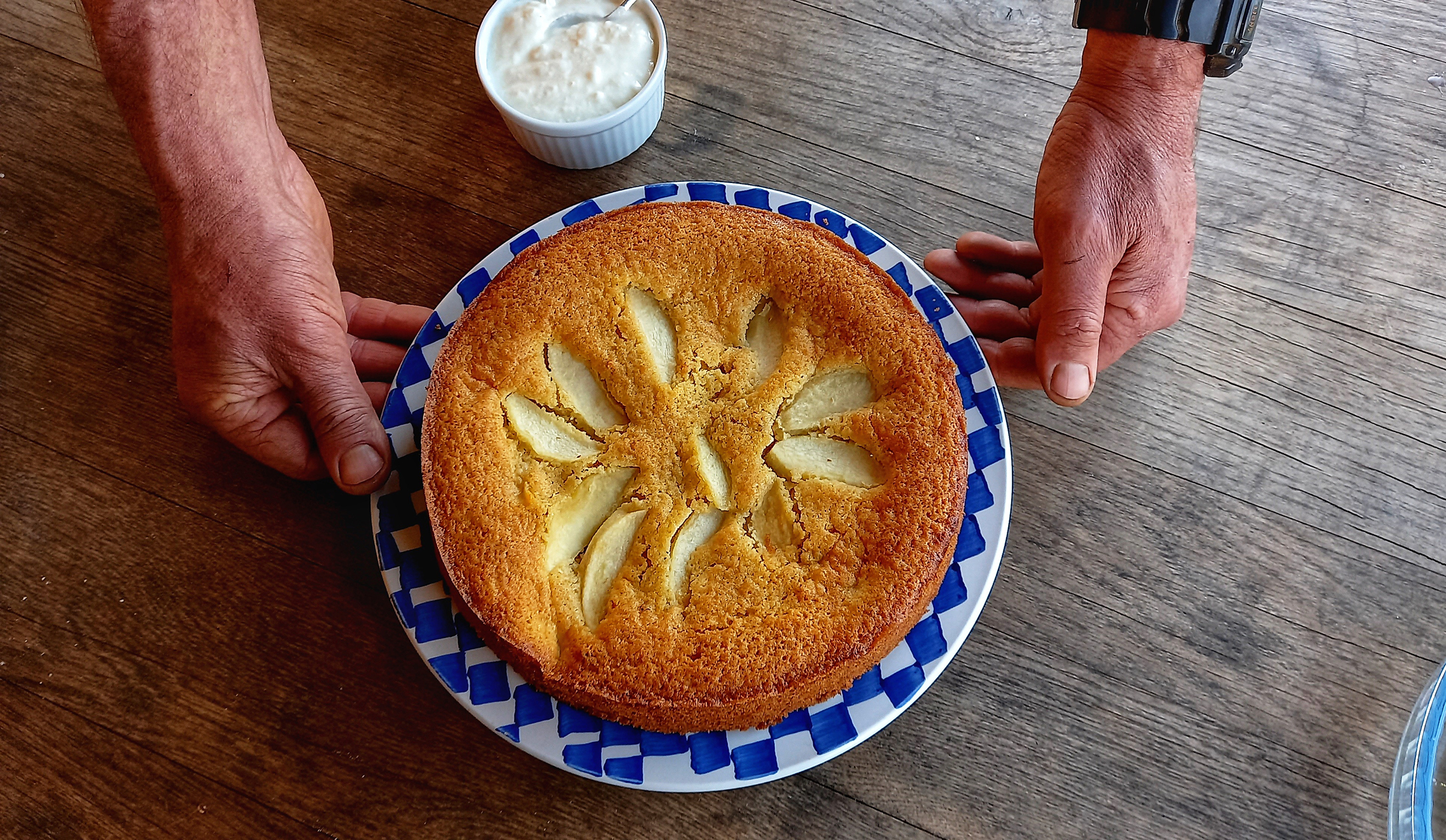
At 11.30 we break for Richard Haigh’s apple, naartjie and pecan nut cake served with strained yoghurt made from Blossom’s milk. (Photo: Wanda Hennig)
Purple potted beans. Broad beans. Strawberries. Leeks. Red onions. Cucurbita. Red chard. Chinese cabbage. Buckwheat. Chickpeas. “Once you’ve eaten a green chickpea you’ll never eat a dry one again. They are fantastic.” Broad beans – different varieties.
“Growing such diversity, one is pushed to be creative, to find interesting things to do what you harvest,” Haigh says while we are harvesting dried beans from an arbour in the veggie garden with a colourful mosaic that is closest to the house.
He’d called me from the milking. “It’s meant to rain tomorrow. We need to get to those beans.” There I’d being encouraged by one of Enaleni’s current student agric interns to try out my (lack of) milking skills on Moonie, the “pure” Saanen goat (Toggles and Skippy are cross-Saanen, a Swiss breed and the most productive milk goat of Switzerland, which has the most productive milking goats in the world).
That was all before our bowls of oats for breakfast, cooked by one of many friends who seem to pop in regularly for a day or two to enjoy the farm and help out. Oats with pecan nuts from the garden and coffee, ground in an antique hand-grinder. Milk still warm from Blossom poured in.
Then later, after donkey training time, a break for more coffee and a slice of Haigh’s specially made apple, pecan and naartjie cake with a dollop of strained yoghurt, made from an earlier Blossom milking. A break from the work of the farm, which operates to a strict schedule.
It’s good to meet a man who says he is happy in his life and clear as daylight, living it with a blend of compassion and passion. Generating income from the small guesthouse, from his classes and events, sometimes from private parties he is asked to cater and from selling surplus produce: his fruit and veg bottlings and cheeses and fresh veggies and eggs.
As it is a small farm, he can’t keep everything he breeds. “And a lot of people are interested in heritage breeds, breeding stock.”
He would like to have people with an interest in learning about what he’s doing come live and work on the farm. He envisages it as being like WWOOF (Worldwide Opportunities on Organic Farms) where “willing workers come and work for so many hours a day and basically you provide a meal. I think at this global time there are people who would really like to come and develop some skills. But the trick for me, really, is how to get it to pay for itself?”
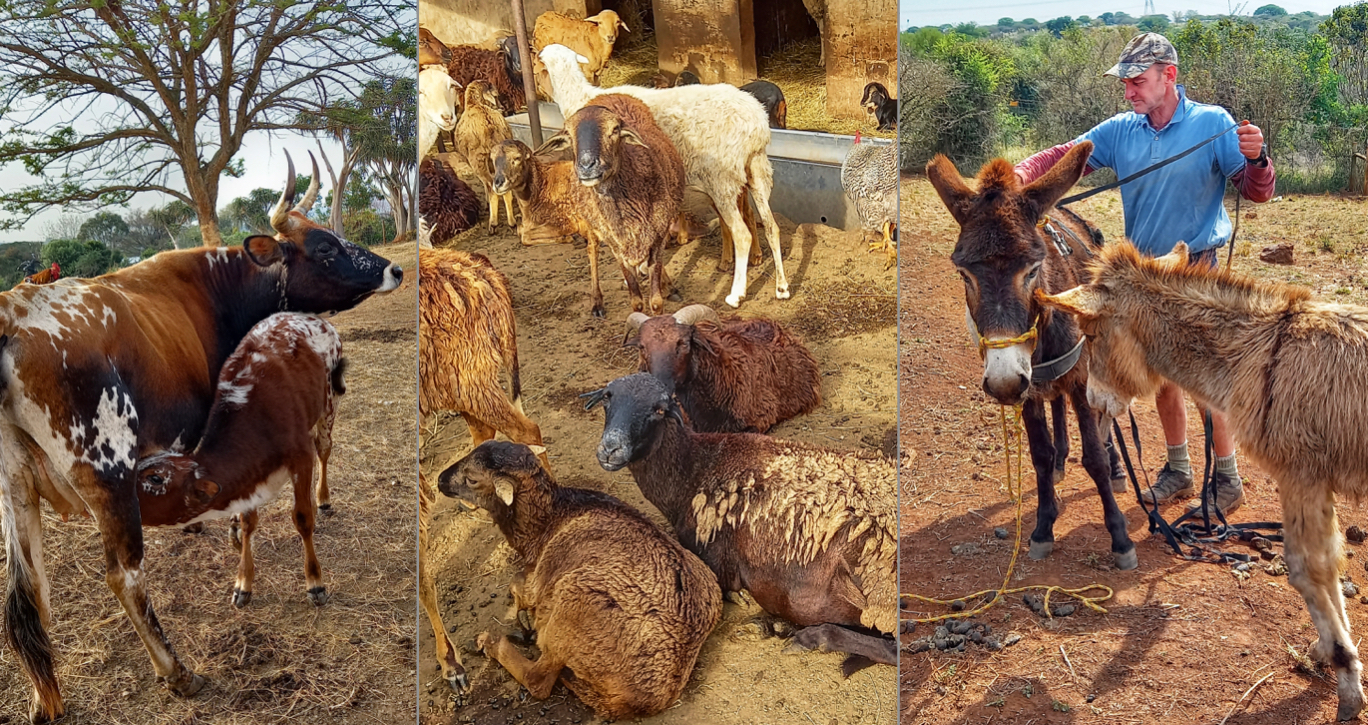
Left to right, Blossom feeds Buttercup. Hello, Zulu sheep! Richard Haigh adapts rescue donkeys to the harness. (Photo: Wanda Hennig)
Haigh has a degree in horticulture. While working in a former life in the NGO sector (at the Valley Trust), among other things promoting sustainable land use practices among marginalised and impoverished rural people, “I realised it was easy to work with plants. It is common to have seed fairs and seed workshops and to bring things to seed exchanges.
“But what about the animals, which are more dependent. Domestic animals are becoming extinct at the rate of two breeds per week. You don’t just whip a sheep from your pocket, like you do with seeds.”
That is the background to his love affair with heritage breeds. His excitement around the animals, many of which he has sought out, tracked down.
Back to the donkeys. Skippy, Toggles, Lily, Jasmine, Ben, Pedro. These were among 10 who were terrified and traumatised when Haigh took them in as rescues last April. They had been found crammed into a truck, which was stopped by a SAPS roadblock. Some were dead. All were abused. The SPCA got involved.
They were poached donkeys being taken to Lesotho where they would have been starved, he says, because then it is easier to get the skin off. These skins would have been sent to China where, according to stories such as this and this, they are boiled down to get a gelatine used in traditional medicines and as an aphrodisiac.
It took several months of gentle treatment to get the donkeys to develop trust and allow touch. It happened slowly, gently, with the help of a friend who is also able to work with them according to their different temperaments, not trying to control them. “They all have individual personalities,” says Haigh, who has introduced them to harnesses. Is training them slowly but surely so they will be able to pull a basic implement to weed and furrow the soil between harvests. “Earn their keep on the farm, getting them back to the land, into service, being the working animals they are meant to be.
“The donkey is one of few African domesticated animals. From the markings on the legs of some of these, you can see their link back to the African wild ass (a critically endangered species).”
Thinking ahead, beyond the two pastures he is currently growing, starting with the regeneration of the soil, “as a way forward for me, what I really want to do, I want to get back into animal traction (the use of animals to pull farm equipment).
“People are beginning to make the shift in understanding that literally treading lightly on the earth has many advantages in terms of our crop production systems and soil health.
“I have a calf that was born two days ago,” he continues, this by message some days after my visit, “and that calf is a dairy calf, a Jersey calf cross Nguni. I’m going to train him with time, turn him into “an oxen” and I’ll be able to use his manure and urine on the farm but also his Jersey side will give him that good temperament and I’ll be able to use him for very light cultivation.
“I’m excited by that and he’s a lovely animal. Really a beauty. The mom is Vygie, the calf is Msizi. I think it will be nice to amplify the link between animals and food production in a very practical way that restores soil health and soil microbes and soil structure.” Food for thought, for the soil, for the table. DM/TGIFood
Visit the Enaleni Farm website | Follow on Facebook and Instagram
Follow Wanda on Instagram wanda_hennig



 Become an Insider
Become an Insider
Comments - Please login in order to comment.